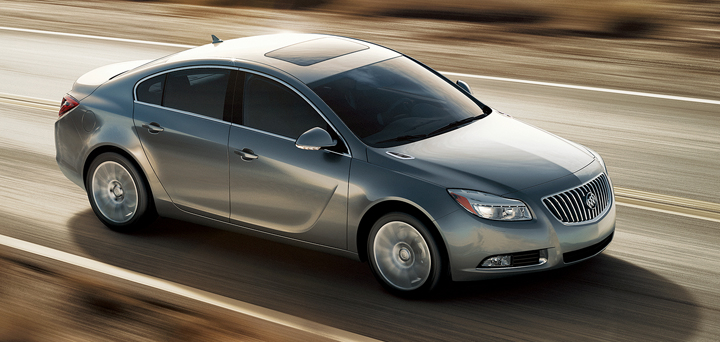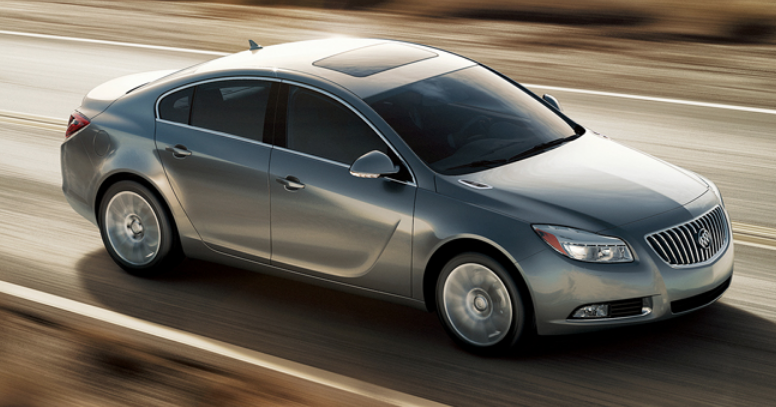
Note: This report supplements Consumer Guide Automotive’s full report on the 2012 Buick Regal, a premium-midsize car that starts at $26,670. Also see our full report on the 2013 Buick Regal.
Heir to the Estate: 2018 Buick Regal Returns as Wagon
Test car came equipped with: 20-inch polished alloy wheels as the only option. Total MSRP with $885 destination charge = $36,420.
Readers should note that this test car is essentially a “2012½” model, as the automatic transmission became available during this model year. The GS debuted for 2011 with 6-speed manual as the only transmission.
Powertrain: 270-horsepower 2.0-liter turbocharged 4-cylinder engine, 6-speed automatic transmission, front-wheel drive.
Acceleration: The test car made Buick’s 6.7-second 0-60-mph claim feel a bit conservative. And indeed, I’ve seen published road tests citing 6.4-6.5 seconds with automatic. No matter. The GS is satisfyingly quick off the line, abetted by virtually no turbo lag, as the main report notes. It also has strong mid-range passing power, abetted by the generally quick-witted automatic transmission. The one downside is lack of ready power coming out of low-speed turns, a common problem with small turbo engines driving economy-biased automatics. In this case, the transmission seeks top gear at the earliest possible moment and takes a critical second or more to answer the throttle at low speeds, almost as if it’s “hanging up” in 2nd gear. You can get around this with the shifter’s manual gate. Steering-wheel paddles would be more convenient, but they’re not available.
Fuel Economy: This test car averaged 19.5 mpg in Phoenix-area driving that was mostly city/suburban running. That compares with 19.6 mpg for the manual-shift GS tested by my colleagues and suggests that, in this case at least, there’s no mileage penalty for self-shift convenience.
Ride Quality: I haven’t driven a GS on the standard 19-inch wheels, but I’d recommend against the optional 20s fitted to this test car. Aside from looking a bit tawdry (my opinion), they wear Y-rated 255/35ZR tires (Pirelli P Zero in this case), which have too little sidewall to cope well with sharp bumps, divots, and especially corrugated surfaces, all of which register quite clearly. As you might imagine, ride comfort is best in the suspension’s normal mode, though even that doesn’t smother bumps so much as trace them. Selecting Sport or GS merely adds to rough-surface jiggle—not much, but enough to be irritating.
Steering/handling/braking: My colleagues are right. The Regal drives almost like a premium European sedan—no surprise, as it’s based on the mainstream but award-winning Euro-market Opel/Vauxhall Insignia. The chassis is retuned for U.S. conditions and driver tastes. Considering how much power is channeled through the front wheels, my test GS was impressively free of unwanted steering-wheel tug (torque-steer) in full-bore acceleration, so the suspension engineers obviously did their homework. A couple more observations: First, steering effort increases a bit after pushing the Sport or GS buttons, which is great for high-speed safety but doesn’t much improve steering feel, which is always a bit numb on-center. Second, even the tautly suspended GS leans a bit in tight corners, though not enough to compromise agility. Finally, the GS stops with smooth, progressive authority and little nosedive, thanks to its big premium Brembo-brand discs and the firm suspension.
Quietness: The GS turbo four is decently quiet in normal driving—helped by the top-gear-biased transmission programming—but it gets a little raucous at higher rpm, though it’s smooth and eager to spin. It also has a nice, racy sound. But tire roar is the main issue here, as my colleagues note. In the GS, it’s bad enough on coarse pavement to require turning up the stereo, and it never goes away completely even on glassy asphalt.
Controls: There’s little I can add to the main-report comments except for noting that the buttons in the center-dash/console area are not very well organized, at least for my liking. A small curiosity: The GS has standard fob-in-pocket locking and pushbutton starting, yet it comes with a conventional “switchblade” key fob.
Details: I can’t agree entirely with the main report here. In my view, Regal’s cabin décor is nice, but not very much nicer than a Chevrolet Malibu’s. The materials, though acceptable at this price level, are “generic GM,” not truly premium. Ditto the operation of the glovebox door and power-window switch. In fact, this test car’s glovebox door had a rather “casual” fit. I do agree that the GS’s piano-black trim is uninspired, and I would say the same for the matte-silver faux-metal accents and even the leather upholstery. Color-matching among various interior pieces could be better, too. On the plus side, this test car was rattle-free and its structure felt reassuringly solid on rough roads.
Room/comfort (front): The main report echoes my views, although this 6-footer had no trouble getting in or out.
Room/comfort (rear): Regal is smaller outside than many class rivals, which explains why rear legroom “is not great for a midsize car.” Still, I could “sit behind myself,” as it were, and not feel cramped. Cozy maybe, but not cramped. I would say entry/exit is a little tight for larger persons, especially if a front seat is pushed very far back. The rear bench is nothing special, nor is it wide enough for three adults unless they’re very friendly.
Cargo room: The trunk is definitely a bit small for a midsize car, and its narrow opening precludes loading really bulky objects, but it’s otherwise OK. At least the rear seatbacks flop down and lie mostly flat. I agree that small-item storage is just average.
CP Says . . . The main-report summary says all you need to know. I was impressed with a test 2011 eAssist Regal, and I’m impressed by this GS, but for different reasons. Though both versions are easy to drive, roomy enough, and more than decently built, the GS (or one of the lower-power turbo models) appeals for near-vivid acceleration and the kind of “tossable” handling that defines a true sports sedan. In fact, the Regal GS would make a fine “budget buy” alternative to, say, a BMW 328i or an Audi A4 2.0T, and that’s high praise coming from me. Just understand that despite our “premium midsize” label, the Regal, any Regal, is basically a mass-market product that doesn’t quite match the technical sophistication or workmanship of vaunted import-brand rivals. It comes very close, though, and costs considerably less—which for me is more than enough of a reason to recommend it.
